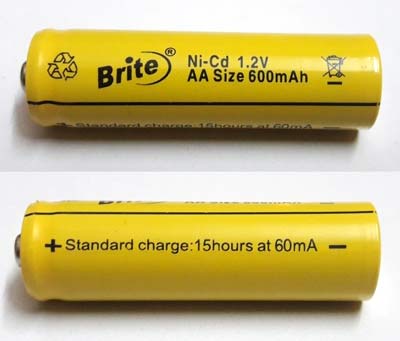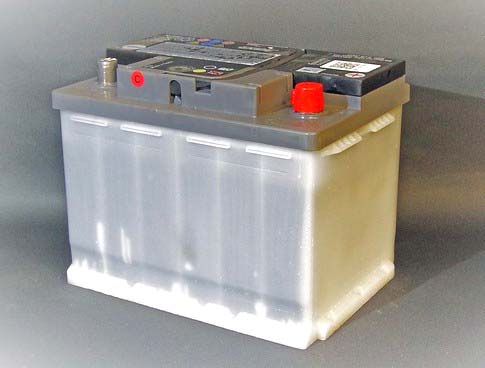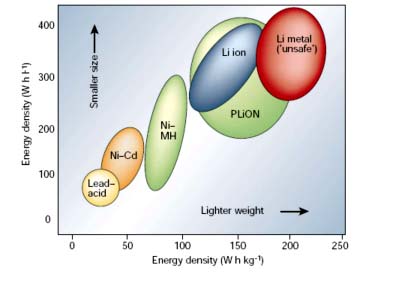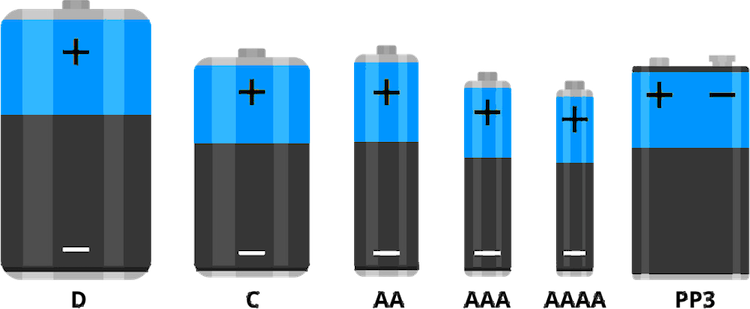
Nowadays batteries are everywhere, you can find them in almost all modern electronics. From watches to computers and EVs to satellites. this wide range of applications calls for a wide range of sizes and types of batteries. Discussing all the available types of batteries is a very huge task and it's a topic for another day. So instead we will discuss the most common battery types we use in our everyday lives. So to start with let's look into the basics first.
A battery is a collection of one or more cells that go under chemical reactions to create the flow of electrons within a circuit. There is lot of research and advancement going on in battery technology, and as a result, breakthrough technologies are being experienced and used around the world currently. Batteries came into play due to the need to store generated electrical energy. As much as a good amount of energy was being generated, it was important to store the energy so it could be used when generation is down or when there is a need to power standalone devices which could not be kept tethered to the supply from the mains. Here it should be noted that only DC can be stored in the batteries, AC can’t be stored. Batteries came into play not only due to the need to store generated electrical energy and for portability purposes.
Battery cells are usually made up of three main components;
- The Anode (Negative Electrode)
- The Cathode (Positive Electrode)
- The electrolytes
The anode is a negative electrode that produces electrons to the external circuit to which the battery is connected. When batteries are connected, an electron build-up is initiated at the anode which causes a potential difference between the two electrodes. The electrons naturally then try to redistribute themselves, this is prevented by the electrolyte, so when an electrical circuit is connected, it provides a clear path for the electrons to move from the anode to the cathode thereby powering the circuit to which it is connected. By changing the arrangement and material used to build the Anode, Cathode and Electrolyte we can achieve many different types of battery chemistries enabling us to design different types of battery cells. In this article lets understand the different types of batteries and their uses, so let's get started.
Types of Batteries
Batteries generally can be classified into different categories and types, ranging from chemical composition, size, form factor and use cases, but under all of these are two major battery types;
- Primary Batteries
- Secondary Batteries
Let's take a deeper look to understand the major differences between a Primacy cell and Secondary Cell.
1. Primary Batteries
Primary batteries are batteries that cannot be recharged once depleted. Primary batteries are made of electrochemical cells whose electrochemical reaction cannot be reversed.
Primary batteries exist in different forms ranging from coin cells to AA batteries. They are commonly used in standalone applications where charging is impractical or impossible. A good example of which is in military grade devices and battery powered equipment. It will be impractical to use rechargeable batteries as recharging a battery will be the last thing in the mind of the soldiers. Primary batteries always have high specific energy and the systems in which they are used are always designed to consume low amount of power to enable the battery last as long as possible.

Some other examples of devices using primary batteries include; Pace makers, Animal trackers, Wrist watches, remote controls and children toys to mention a few.
The most popular type of primary batteries are alkaline batteries. They have a high specific energy and are environmentally friendly, cost-effective and do not leak even when fully discharged. They can be stored for several years, have a good safety record and can be carried on an aircraft without being subject to UN Transport and other regulations. The only downside to alkaline batteries is the low load current, which limits its use to devices with low current requirements like remote controls, flashlights and portable entertainment devices. Other types of commonly used primary batteries include Zinc-Carbon batteries, Lithium batteries, mercury batteries, Silver-Oxide batteries, Zinc-air batteries and Zinc-Chloride batteries.
2. Secondary Batteries
Secondary batteries are batteries with electrochemical cells whose chemical reactions can be reversed by applying a certain voltage to the battery in the reversed direction. Also referred to as rechargeable batteries, secondary cells unlike primary cells can be recharged after the energy on the battery has been used up.
They are typically used in high drain applications and other scenarios where it will be either too expensive or impracticable to use single charge batteries. Small capacity secondary batteries are used to power portable electronic devices like mobile phones, and other gadgets and appliances while heavy-duty batteries are used in powering diverse electric vehicles and other high drain applications like load levelling in electricity generation. They are also used as standalone power sources alongside Inverters to supply electricity. Although the initial cost of acquiring rechargeable batteries is always a whole lot higher than that of primary batteries but they are the most cost-effective over the long-term. If you are interested in Electric vehicle batteries you can check out this article on Electric Car batteries to know more.
Secondary batteries can be further classified into several other types based on their chemistry. This is very important because the chemistry determines some of the attributes of the battery including its specific energy, cycle life, shelf life, and price to mention a few.
The following are the different types of rechargeable batteries that are commonly used.
- Nickel Cadmium(Ni-Cd)
- Nickel-Metal Hydride(Ni-MH)
- Lead-Acid
- Lithium-ion(Li-ion)
- Lithium iron phosphate(LiFePO4)
- Lithium Nickel Manganese Cobalt Oxide (NMC)
- Lithium Nickel Cobalt Aluminum Oxide (NCA)
- Lithium Cobalt Oxide (LCO)
- Lithium Manganese Oxide (LMO)
- Lithium Titanate (LTO)
1. Nickel-Cadmium Batteries
The nickel–cadmium battery (NiCd battery or NiCad battery) is a type of rechargeable battery which is developed using nickel oxide hydroxide and metallic cadmium as electrodes. Ni-Cd batteries excel at maintaining voltage and holding charge when not in use. However, NI-Cd batteries easily fall a victim of the dreaded “memory” effect when a partially charged battery is recharged, lowering the future capacity of the battery.

In comparison with other types of rechargeable cells, Ni-Cd batteries offer good life cycle and performance at low temperatures with a fair capacity but their most significant advantage will be their ability to deliver their full rated capacity at high discharge rates. They are available in different sizes including the sizes used for alkaline batteries, AAA to D. Ni-Cd cells are used individual or assembled in packs of two or more cells. The small packs are used in portable devices, electronics and toys while the bigger ones find application in aircraft starting batteries, Electric vehicles and standby power supply.
Some of the properties of Nickel-Cadmium batteries are listed below.
- Specific Energy: 40-60W-h/kg
- Energy Density: 50-150 W-h/L
- Specific Power: 150W/kg
- Charge/discharge efficiency: 70-90%
- Self-discharge rate: 10%/month
- Cycle durability/life: 2000cycles
2. Nickel-Metal Hydride Batteries
Nickel metal hydride (Ni-MH) is another type of chemical configuration used for rechargeable batteries. The chemical reaction at the positive electrode of batteries is similar to that of the nickel–cadmium cell (NiCd), with both battery type using the same nickel oxide hydroxide (NiOOH). However, the negative electrodes in Nickel-Metal Hydride use a hydrogen-absorbing alloy instead of cadmium which is used in NiCd batteries
.
NiMH batteries find application in high drain devices because of their high capacity and energy density. A NiMH battery can possess two to three times the capacity of a NiCd battery of the same size, and its energy density can approach that of a lithium-ion battery. Unlike the NiCd chemistry, batteries based on the NiMH chemistry are not susceptible to the “memory” effect that NiCads experience.
Below are some of the properties of batteries based on the Nickel-metal hydride chemistry;
- Specific Energy: 60-120h/kg
- Energy Density: 140-300 Wh/L
- Specific Power: 250-1000 W/kg
- Charge/discharge efficiency: 66% - 92%
- Self-discharge rate: 1.3-2.9%/month at 20oC
- Cycle Durability/life: 180 -2000
3. Lead-Acid Batteries
Lead-acid batteries are a low-cost reliable power workhorse used in heavy-duty applications. They are usually very large and because of their weight, they’re always used in non-portable applications such as solar-panel energy storage, vehicle ignition and lights, backup power and load levelling in power generation/distribution. The lead-acid is the oldest type of rechargeable battery and still very relevant and important into today’s world. Lead-acid batteries have very low energy to volume and energy to weight ratios but it has a relatively large power to weight ratio and as a result, can supply huge surge currents when needed. These attributes alongside its low cost make these batteries attractive for use in several high current applications like powering automobile starter motors and for storage in backup power supplies. You can also check out the article on Lead Acid Battery working if you want to know more about the different types of Lead-acid batteries, its construction and applications.

4. Lithium-ion Batteries
Lithium-ion batteries are one of the most popular types of rechargeable batteries. There are many different types of Lithium batteries, but among all the lithium-ion batteries are the most commonly used. You can find these lithium batteries being used in different forms popularly among electric vehicles and other portable gadgets. If you are curious to know more about batteries used in Electric vehicles, you can check out this article on Electric Vehicle Batteries. They are found in different portable appliances including mobile phones, smart devices and several other battery appliances used at home. They also find applications in aerospace and military applications due to their lightweight nature.

Lithium-ion batteries are a type of rechargeable battery in which lithium ions from the negative electrode migrate to the positive electrode during discharge and migrate back to the negative electrode when the battery is being charged. Li-ion batteries use an intercalated lithium compound as one electrode material, compared to the metallic lithium used in non-rechargeable lithium batteries.
Lithium-ion batteries generally possess high energy density, little or no memory effect and low self-discharge compared to other battery types. Their chemistry alongside performance and cost vary across different use cases, for example, Li-ion batteries used in handheld electronic devices are usually based on lithium cobalt oxide (LiCoO2) which provides high energy density and low safety risks when damaged while Li-ion batteries based on Lithium iron phosphate which offer a lower energy density are safer due to a reduced likelihood of unfortunate events happening are widely used in powering electric tools and medical equipment. Lithium-ion batteries offer the best performance to weight ratio with the lithium sulphur battery offering the highest ratio.
Some of the attributes of lithium-ion batteries are listed below;
- Specific Energy: 100: 265W-h/kg
- Energy Density: 250: 693 W-h/L
- Specific Power: 250: 340 W/kg
- Charge/discharge percentage: 80-90%
- Cycle Durability: 400: 1200 cycles
- Nominal cell voltage: NMC 3.6/3.85V
Within the Li-ion batteries, there are several types depending on the battery chemistry used. Here are some of the most popular Li-Ion battery types.
a. Lithium Iron Phosphate Batteries
Due to the use of iron and phosphate in manufacturing, LiFePO4 batteries are cheaper to make than the common Li-Ion variants. However, they offer lesser specific energy comparatively. Additionally, LiFePO4 batteries are considered one of the safest types of rechargeable Lithium batteries and have a long lifespan. Nowadays they are very popular among to use with power backup systems due to their low price and safety.
b. Lithium Nickel Manganese Cobalt Oxide (NMC)
In an NMC battery the cathodes typically contain large proportions of nickel, which increases the battery energy density. However, this high nickel content makes the battery highly unstable and dangerous. To make the NMC batteries more thermally stable and safe, manganese and cobalt are added. Depending on on the exact chemical composition, there are several sub-types within the NMC batteries, like NMC811, NMC532 and NMC622 etc.
c. Lithium Nickel Cobalt Aluminum Oxide (NCA)
NCA shares similar battery chemistry with the NMC type. But instead of manganese, aluminium is used as a stability agent. Compared to other Li-ion batteries, NCA batteries and typically more expensive and less safe.
d. Lithium Cobalt Oxide (LCO)
When compared to other Li-ion batteries, LCO batteries offer high energy density. But it also comes with some drawbacks such as relatively shorter battery life, low thermal stability, limited specific power etc. But since they pack higher energy they are a very popular choice for applications such as smartphones, laptops and other electronic gadgets, where a low amount of power for a longer duration is needed.
e. Lithium Manganese Oxide (LMO)
The Lithium Manganese Oxide (LMO) offers faster charging and discharging capabilities along with higher stability. They can provide much higher current for shorter durations, than other types of batteries. They are even used in combination with NMC chemistry in EVs, due to their higher current capability.
e. Lithium Titanate (LTO)
Unlike the other chemistries above, where the cathode composition makes the difference, LTO batteries use a unique anode surface made of lithium and titanium oxides. These batteries exhibit excellent safety and performance under extreme temperatures but have low capacity and are relatively expensive, limiting their use at scale.
Each of these batteries has its area of best fit and the image below is to help choose between them.

Different battery sizes
As we know about different batteries based on their chemistry, now let's look into the different battery sizes or packages. Since covering all available packages is difficult and unnecessary we are going to look at the most commonly used battery types. To start with let's look at the different types of primary batteries we use. The image below shows the different non-rechargeable battery types we use every day. The bigger brothers D and C-type batteries are normally used in devices such as radios, cassette players, toys, and flashlights. The AA, AAA, and AAAA were commonly used in devices such as alarm clocks, portable electronics, remote controls, etc. The PP3 or 6F22 batteries are mostly used in industrial test equipment such as multimeters, cable testers, etc.

Another type of battery we use is the one commonly known as the coin battery. they are small in size and look like a coin or a button. they are most commonly used in devices with very low power consumption such as watches, calculators and car keys. you can also find them in most devices with an RTC in it. They are used in such devices only to provide backup power to RTC chips for timekeeping. Here are some of the most commonly used coin batteries.

Now if we look at the rechargeable batteries they are available in a ton of different package types. Here we are going to look at the different cylindrical rechargeable battery packages. the NiMH and NiCd batteries are available in common AAA or AA packages, while the Lithium-ion batteries come in their own specific package types. The most common type is the 18650 battery. which can be found in many rechargeable gadgets on the market. Most lithium-ion cylindrical packages are named in such a numeric scheme, in which the first two numbers denote the diameter while the second and third numbers indicate the length. For example, the 18650 battery will be 65mm in length and will have a diameter of 18mm. The below image shows the most popular lithium-iron battery packages.

Selecting the right battery for your application
One of the main problems hindering technology revolutions like IoT is power, battery life affects the successful deployment of devices that require long battery life and even though several power management techniques are being adopted to make the battery last longer, a compatible battery must still be selected to achieve the desired outcome.
Below are some factors to consider when selecting the right type of battery for your project.
1. Energy Density: The energy density is the total amount of energy that can be stored per unit mass or volume. This determines how long your device stays on before it needs a recharge.
2. Power Density: Maximum rate of energy discharge per unit mass or volume. Low power: laptop, i-pod. High power: power tools.
3. Safety: It is important to consider the temperature at which the device you are building will work. At high temperatures, certain battery components will breakdown and can undergo exothermic reactions. High temperatures generally reduces the performance of most batteries.
4. Life cycle durability: The stability of energy density and power density of a battery with repeated cycling (charging and discharging) is needed for the long battery life required by most applications.
5. Cost: Cost is an important part of any engineering decisions you will be making. It is important that the cost of your battery choice is commensurate with its performance and will not increase the overall cost of the project abnormally.






Sir,
Please let us know technology spot welding for cells as well as connecting bars &where can we locate for spot weling.
Regards
Seema Joshi